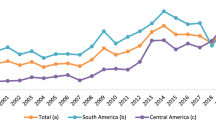Abstract
This article examines trends in, and composition of, public expenditures for 147 countries from 1980 to 2010. Total public spending has increased significantly for these countries as a whole. While the developed world still accounts for the majority of absolute size of spending, some regions in the developing world (particularly in Asia) have observed a rapid expansion mainly due to their robust economic growth. Developing countries have also outperformed their developed counterparts in investments in productive sectors such as agriculture and infrastructure when measured as their shares of total spending. Both developing and developed countries have observed substantial growth of social protection spending, with growth in developed countries much more pronounced. Over the period of 1980–2010, the level and composition of public expenditure in the social sector and social protection diverged across regions but converged in agriculture and infrastructure expenditure.
Abstract
Ce document examine les tendances en, et la composition des, dépenses publiques pour les 147 pays de 1980 à 2010. Le total des dépenses publiques a augmenté de manière significative pour l’ensemble de ces pays. Alors que le monde développé représente encore la majorité du montant absolu des dépenses, certaines régions du monde en développement (en particulier en Asie) ont observé une expansion rapide principalement en raison de leur forte croissance économique. Les pays en développement ont également dépassé leurs homologues développés quant aux investissements dans les secteurs productifs tels que l'agriculture et l'infrastructure, lorsqu’on observe la proportion de ces investissements par rapport à leurs dépenses totales. Les pays développés et en développement ont tous observé une croissance importante des dépenses de protection sociale, avec une croissance beaucoup plus prononcée dans les pays développés. Au cours de la période de 1980–2010, le niveau et la composition des dépenses publiques dans le secteur social et la protection sociale sont disparates entre les régions, mais sont similaires en ce qui concerne les dépenses agricoles et d'infrastructure.


Similar content being viewed by others
Notes
COFOG splits total government expenditure data into 10 functional groups or sub-sectors of expenditures: (i) general public services, (ii) defence, (iii) public order and safety, (iv) economic affairs, (v) environmental protection, (vi) housing and community amenities, (vii) health, (viii) recreation, culture and religion, (ix) education and (x) social protection. Within economic affairs, there are sub-groups including (i) general economic, commercial and labour affairs, (ii) agriculture, forestry, fishing and hunting, (iii) fuel and energy, (iv) mining, manufacturing and construction, (v) transport, (vi) communication, (vii) other industries, (viii) R&D economic affairs and (ix) other. Within economic affairs, most countries only report consistently expenditures in agriculture, transport and communication, but not other sub-groups.
It would be ideal to distinguish subsidies and investment/research expenditures for a thorough understanding of within-sector allocation. According to the COFOG definition, subsidy is part of the economic classification while research and development falls under the functional classification. A cross-classification of expenditures is a challenging task for researchers and SPEED has not compiled this type of information from international and national sources.
The least square growth rates were used to estimate growth rates by regressing the levels of expenditures in natural logarithms against the time trend. Subsequently, the coefficient of the time period is exponentiated, subtracted by 1 and multiplied by 100. This method is less sensitive to outliers at the starting and ending year because it takes into account all the observations and gives more robust results than the geometric growth method (World Bank, 2014b). The aggregates are weighted over population to avoid skewness (distortion) caused by any large economies or country coverage.
According to COFOG, social protection expenditures include sickness and disability, old age, survivors, family and children, unemployment, housing, social exclusion not elsewhere classified, R&D social protection, and social protection not elsewhere classified.
References
African Union (2003) Declaration on Agriculture and Food Security in Africa. Assembly/AU/Decl.4-11 (II) Addis Ababa, Ethiopia: African Union.
Benin, S. and Yu, B. (2013) Complying with the Maputo Declaration Target: Trends in Public Agricultural Expenditures and Implications for Pursuit of Optimal Allocation of Public Agricultural Spending. ReSAKSS Annual Trends and Outlook Report 2012. Washington DC: International Food Policy Research Institute.
Fan, S., Yu, B. and Saurkar, A. (2008) Public spending in developing countries: Trends, determination, and impact. In: S. Fan (ed.) Public Expenditures, Growth, and Poverty. Baltimore, MD: Johns Hopkins University Press, pp. 20–55.
FAO (2012) The State of Food and Agriculture: Investing in Agricultural for a Better Future. Rome, Italy: Food and Agriculture Organization of the United Nations.
Gwartney, J., Holcombe, R. and Lawson, R. (1998) The scope of government and the wealth of nations. Cato Journal 18 (2): 163–190.
IMF (2001) Government Finance Statistics Manual 2001. Washington DC: International Monetary Fund.
IFPRI (2013) The Statistics on Public Expenditure for Economic Development (SPEED). Washington DC: International Food Policy Research Institute.
IFPRI (2014) Global Food Policy Report 2014. Washington DC: International Food Policy Research Institute.
Islam, N. (2011) Foreign Aid to Agriculture: Review of Facts and Analysis. Discussion Paper 01053. Washington DC: International Food Policy Research Institute.
Jha, R.K. and Bhattacharyya, S. (2010) Social Security System in India: An International Comparative Analysis. MPRA (Munich Personal RePEc Archive) Paper No. 20142, http://mpra.ub.uni-muenchen.de/20142/1/MPRA_paper_20142.pdf.
Mogues, F., Fan, S. and Benin, D. (2015) Public Investments in and for Agriculture. European Journal of Development Research, 27 (3): 337–352.
World Bank (2014a) What methods are used to calculate aggregates for groups of countries? https://datahelpdesk.worldbank.org/knowledgebase/articles/198549-what-methods-are-used-to-calculate-aggregates-for, accessed 3 December 2014.
World Bank (2014b) Methodologies, http://data.worldbank.org/about/data-overview/methodologies, accessed 3 December 2014.
World Bank (2014c) Structural adjustment programs, http://www.worldbank.org/development/sap.html, accessed 4 December 2014.
Author information
Authors and Affiliations
Appendix
Appendix
Rights and permissions
About this article
Cite this article
Yu, B., Fan, S. & Magalhães, E. Trends and Composition of Public Expenditures: A Global and Regional Perspective. Eur J Dev Res 27, 353–370 (2015). https://doi.org/10.1057/ejdr.2015.26
Published:
Issue Date:
DOI: https://doi.org/10.1057/ejdr.2015.26




